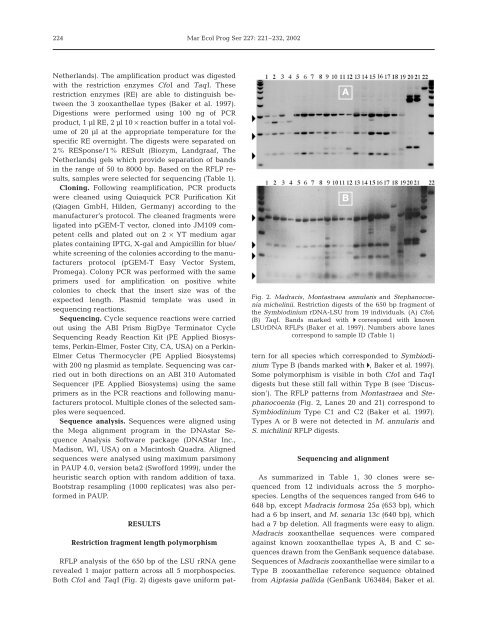No habitat correlation of zooxanthellae in the coral ... - Inter Research
No habitat correlation of zooxanthellae in the coral ... - Inter Research
No habitat correlation of zooxanthellae in the coral ... - Inter Research
You also want an ePaper? Increase the reach of your titles
YUMPU automatically turns print PDFs into web optimized ePapers that Google loves.
224<br />
Ne<strong>the</strong>rlands). The amplification product was digested<br />
with <strong>the</strong> restriction enzymes CfoI and TaqI. These<br />
restriction enzymes (RE) are able to dist<strong>in</strong>guish between<br />
<strong>the</strong> 3 <strong>zooxan<strong>the</strong>llae</strong> types (Baker et al. 1997).<br />
Digestions were performed us<strong>in</strong>g 100 ng <strong>of</strong> PCR<br />
product, 1 µl RE, 2 µl 10 × reaction buffer <strong>in</strong> a total volume<br />
<strong>of</strong> 20 µl at <strong>the</strong> appropriate temperature for <strong>the</strong><br />
specific RE overnight. The digests were separated on<br />
2% RESponse/1% RESult (Biozym, Landgraaf, The<br />
Ne<strong>the</strong>rlands) gels which provide separation <strong>of</strong> bands<br />
<strong>in</strong> <strong>the</strong> range <strong>of</strong> 50 to 8000 bp. Based on <strong>the</strong> RFLP results,<br />
samples were selected for sequenc<strong>in</strong>g (Table 1).<br />
Clon<strong>in</strong>g. Follow<strong>in</strong>g reamplification, PCR products<br />
were cleaned us<strong>in</strong>g Quiaquick PCR Purification Kit<br />
(Qiagen GmbH, Hilden, Germany) accord<strong>in</strong>g to <strong>the</strong><br />
manufacturer’s protocol. The cleaned fragments were<br />
ligated <strong>in</strong>to pGEM-T vector, cloned <strong>in</strong>to JM109 competent<br />
cells and plated out on 2 × YT medium agar<br />
plates conta<strong>in</strong><strong>in</strong>g IPTG, X-gal and Ampicill<strong>in</strong> for blue/<br />
white screen<strong>in</strong>g <strong>of</strong> <strong>the</strong> colonies accord<strong>in</strong>g to <strong>the</strong> manufacturers<br />
protocol (pGEM-T Easy Vector System,<br />
Promega). Colony PCR was performed with <strong>the</strong> same<br />
primers used for amplification on positive white<br />
colonies to check that <strong>the</strong> <strong>in</strong>sert size was <strong>of</strong> <strong>the</strong><br />
expected length. Plasmid template was used <strong>in</strong><br />
sequenc<strong>in</strong>g reactions.<br />
Sequenc<strong>in</strong>g. Cycle sequence reactions were carried<br />
out us<strong>in</strong>g <strong>the</strong> ABI Prism BigDye Term<strong>in</strong>ator Cycle<br />
Sequenc<strong>in</strong>g Ready Reaction Kit (PE Applied Biosystems,<br />
Perk<strong>in</strong>-Elmer, Foster City, CA, USA) on a Perk<strong>in</strong>-<br />
Elmer Cetus Thermocycler (PE Applied Biosystems)<br />
with 200 ng plasmid as template. Sequenc<strong>in</strong>g was carried<br />
out <strong>in</strong> both directions on an ABI 310 Automated<br />
Sequencer (PE Applied Biosystems) us<strong>in</strong>g <strong>the</strong> same<br />
primers as <strong>in</strong> <strong>the</strong> PCR reactions and follow<strong>in</strong>g manufacturers<br />
protocol. Multiple clones <strong>of</strong> <strong>the</strong> selected samples<br />
were sequenced.<br />
Sequence analysis. Sequences were aligned us<strong>in</strong>g<br />
<strong>the</strong> Mega alignment program <strong>in</strong> <strong>the</strong> DNAstar Sequence<br />
Analysis S<strong>of</strong>tware package (DNAStar Inc.,<br />
Madison, WI, USA) on a Mac<strong>in</strong>tosh Quadra. Aligned<br />
sequences were analysed us<strong>in</strong>g maximum parsimony<br />
<strong>in</strong> PAUP 4.0, version beta2 (Sw<strong>of</strong>ford 1999), under <strong>the</strong><br />
heuristic search option with random addition <strong>of</strong> taxa.<br />
Bootstrap resampl<strong>in</strong>g (1000 replicates) was also performed<br />
<strong>in</strong> PAUP.<br />
RESULTS<br />
Restriction fragment length polymorphism<br />
RFLP analysis <strong>of</strong> <strong>the</strong> 650 bp <strong>of</strong> <strong>the</strong> LSU rRNA gene<br />
revealed 1 major pattern across all 5 morphospecies.<br />
Both CfoI and TaqI (Fig. 2) digests gave uniform pat-<br />
Mar Ecol Prog Ser 227: 221–232, 2002<br />
A<br />
B<br />
Fig. 2. Madracis, Montastraea annularis and Stephanocoenia<br />
michel<strong>in</strong>ii. Restriction digests <strong>of</strong> <strong>the</strong> 650 bp fragment <strong>of</strong><br />
<strong>the</strong> Symbiod<strong>in</strong>ium rDNA-LSU from 19 <strong>in</strong>dividuals. (A) CfoI;<br />
(B) TaqI. Bands marked with C correspond with known<br />
LSUrDNA RFLPs (Baker et al. 1997). Numbers above lanes<br />
correspond to sample ID (Table 1)<br />
tern for all species which corresponded to Symbiod<strong>in</strong>ium<br />
Type B (bands marked with C, Baker et al. 1997).<br />
Some polymorphism is visible <strong>in</strong> both CfoI and TaqI<br />
digests but <strong>the</strong>se still fall with<strong>in</strong> Type B (see ‘Discussion’).<br />
The RFLP patterns from Montastraea and Stephanocoenia<br />
(Fig. 2, Lanes 20 and 21) correspond to<br />
Symbiod<strong>in</strong>ium Type C1 and C2 (Baker et al. 1997).<br />
Types A or B were not detected <strong>in</strong> M. annularis and<br />
S. michil<strong>in</strong>ii RFLP digests.<br />
Sequenc<strong>in</strong>g and alignment<br />
As summarized <strong>in</strong> Table 1, 30 clones were sequenced<br />
from 12 <strong>in</strong>dividuals across <strong>the</strong> 5 morphospecies.<br />
Lengths <strong>of</strong> <strong>the</strong> sequences ranged from 646 to<br />
648 bp, except Madracis formosa 25a (653 bp), which<br />
had a 6 bp <strong>in</strong>sert, and M. senaria 13c (640 bp), which<br />
had a 7 bp deletion. All fragments were easy to align.<br />
Madracis <strong>zooxan<strong>the</strong>llae</strong> sequences were compared<br />
aga<strong>in</strong>st known <strong>zooxan<strong>the</strong>llae</strong> types A, B and C sequences<br />
drawn from <strong>the</strong> GenBank sequence database.<br />
Sequences <strong>of</strong> Madracis <strong>zooxan<strong>the</strong>llae</strong> were similar to a<br />
Type B <strong>zooxan<strong>the</strong>llae</strong> reference sequence obta<strong>in</strong>ed<br />
from Aiptasia pallida (GenBank U63484; Baker et al.

















